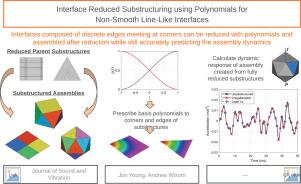Interface reduced substructuring using polynomials for non-smooth line-like interfaces
IF 4.9
2区 工程技术
Q1 ACOUSTICS
引用次数: 0
Abstract
A method for reducing the interface degrees of freedom on a substructure by means of polynomial basis vectors is developed for interfaces composed of distinct edges and corners. The scope is restricted to interfaces with straight line geometry. Two sets of polynomials are utilized to enforce compatibility at corners where two edges meet. The first set accounts for motion at the corners and are referred to as corner polynomials, and the second accounts for higher frequency motion allowing each edge to move independently of the others, referred to as edge polynomials. Due to the interface motion being described by an identical set of basis vectors on adjacent substructures, coupling along interfaces with incompatible meshes is possible without significant loss in the accuracy of dynamic properties of the assembly. This interface reduction technique is discussed in the framework of creating an assembly from copies of a parent substructure, in which the parent substructure has reduced internal and interface degrees of freedom and is then translated and rotated into a larger assembly. The reduced basis is demonstrated on several plate substructures, and shown to provide accurate estimates of the assembly’s dynamic properties. This accuracy increases proportionally with the number of basis vectors used to describe the interface motion, but can deteriorate if the order of the basis polynomials chosen cannot be resolved by the interface mesh.

使用多项式对非光滑线状界面进行界面减少子结构
针对由不同边角组成的界面,提出了一种利用多项式基向量降低子结构上的界面自由度的方法。范围仅限于具有直线几何形状的接口。利用两组多项式在两条边相交的角处加强兼容性。第一组用于角上的运动,称为角多项式,第二组用于允许每条边独立运动的高频运动,称为边多项式。由于界面运动是由相邻子结构上的一组相同的基向量来描述的,因此沿着不兼容网格的界面进行耦合是可能的,而不会对装配的动态特性的精度造成重大损失。在从父子结构的副本创建装配的框架中讨论了这种界面缩减技术,其中父子结构减少了内部和界面自由度,然后被转换和旋转成更大的装配。在几个板子结构上演示了减少的基础,并显示出对装配动态特性的准确估计。这种精度随着用于描述界面运动的基向量的数量成比例地增加,但如果所选择的基多项式的顺序不能被界面网格分解,则会下降。
本文章由计算机程序翻译,如有差异,请以英文原文为准。
求助全文
约1分钟内获得全文
求助全文
来源期刊

Journal of Sound and Vibration
工程技术-工程:机械
CiteScore
9.10
自引率
10.60%
发文量
551
审稿时长
69 days
期刊介绍:
The Journal of Sound and Vibration (JSV) is an independent journal devoted to the prompt publication of original papers, both theoretical and experimental, that provide new information on any aspect of sound or vibration. There is an emphasis on fundamental work that has potential for practical application.
JSV was founded and operates on the premise that the subject of sound and vibration requires a journal that publishes papers of a high technical standard across the various subdisciplines, thus facilitating awareness of techniques and discoveries in one area that may be applicable in others.
 求助内容:
求助内容: 应助结果提醒方式:
应助结果提醒方式:


